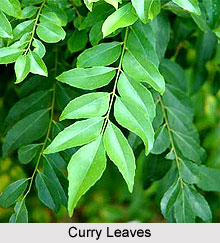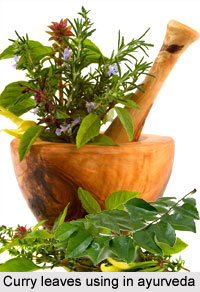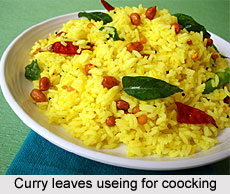 Curry leaves are available from a beautiful, aromatic deciduous Shrub that grows up to 0.9 meter in height. The leaves are little bit bitter and aromatic. Curry leaves posses the qualities of Herbal tonic. The uses of Curry leaves varies from strengthening the stomach functioning and also to restore its activity. It is also used as mild laxative. The leaves are mixed with other mild testing herbs. The juices extracted from the leaves are consumed with buttermilk.
Curry leaves are available from a beautiful, aromatic deciduous Shrub that grows up to 0.9 meter in height. The leaves are little bit bitter and aromatic. Curry leaves posses the qualities of Herbal tonic. The uses of Curry leaves varies from strengthening the stomach functioning and also to restore its activity. It is also used as mild laxative. The leaves are mixed with other mild testing herbs. The juices extracted from the leaves are consumed with buttermilk.
Studies reveal that curry leaves consist 66.3% of Moisture, 16.0% of Carbohydrates, 6.4% of Fibre etc. are useful for producing various products and medical extracts. Fresh leaves on steam distillation under pressure yield a volatile oil. The leaves contain a residual Gluucoside named as Koenigin.
The curry leaves has various health benefits which are listed below:
•Fresh juice of Curry leaves, with Lime juice and Sugar, is useful in treating Morning Sickness, Nausea and Vomiting due to indigestion and excessive use of fats. One or two teaspoons of juice of these leaves mixed with a teaspoon of lime juice can be taken in these conditions. For stomach upset the curry leaves are grounded to a fine paste and mixed with buttermilk.
•Tender curry leaves are useful remedy for treating Diarrhoea, Dysentery and Piles. It should be taken and mixed with honey. The bark of the tree is also useful in Bilious Vomiting. A teaspoon of the powder of the dry bark should be given with cold water in this condition.
•Diabetes due to heredity factors can be cured by eating ten fresh fully grown Curry leaves every morning for three months. It also helps in curing Diabetes due to Obesity due to the weight reducing properties of the leaves.
• Curry leaves can be used with effective results to treat Burns, Bruises and Skin Eruptions. They should be applied as a poultice over the affected areas.
Curry leaves can be used with effective results to treat Burns, Bruises and Skin Eruptions. They should be applied as a poultice over the affected areas.
•Cataract development can be prevented by using fresh juice of Curry leaves. It also makes the eyes look bright.
•The root of the Curry plant also has medicinal properties. Kidney pain can be cured by using the juice of the root.
•Curry leaves are useful in preventing premature greying of hair. These leaves have the property of nourishing the hair roots. The leaves can be used in the form of chutney or the juice may be squeezed and taken buttermilk.
•The Curry plants produce fruits that are green in colour when it is raw and purple when it is ripe. The juice of the berries mixed with equal proportion of Lime juice can be used for external application in Insect Stings and bites of Poisonous creatures.
•When Curry leaves are boiled in coconut till they are reduced to a blackened residue, the oil forms an excellent hair tonic to enhance hair growth and helps in retaining the natural pigmentation.
 The curry leaves finds its applications in various fields and areas of diverse effects. The aromatic use for culinary purposes to medical needs and for simple solution of day to day health problems, it caters to a wide area.
The curry leaves finds its applications in various fields and areas of diverse effects. The aromatic use for culinary purposes to medical needs and for simple solution of day to day health problems, it caters to a wide area.
The leaves of the Curry plants are the edible part and they are shiny, dark green, aromatic and slightly bitter in taste. As the colloquial name suggests, these curry leaves are one of the ingredients of Indian curries, cooked vegetables, salads, chutneys and spices
Uses of Curry leaves are recognised in all kinds of medical treatments and cooking methods as well. Curry leaves are beneficial in problems like constipation, stomach problems, vomiting, nausea, snakebite, spots and rashes. The benefits of curry leaves also owe to its flavour and taste and are added to dishes to enhance the smell and taste of food and its food value. Although the leaves are added to Indian dishes as a natural flavouring agent, it is well known that they have some therapeutic value as well.




















